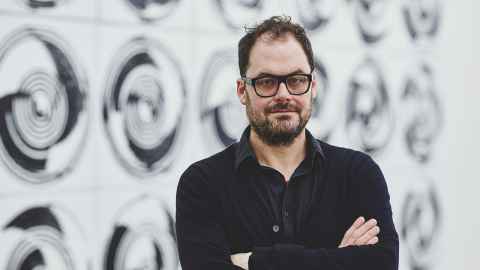Artist Simon Ingram is collaborating with the NZTrio, in a performance in which the brain activity of the musicians will create an artwork, live.

For this year’s Dunedin Art’s Festival, artist researcher Simon Ingram is collaborating with the renowned NZ Trio to interpret the contemporary classical musicians’ brainwaves as a form of painting, while they’re performing.
NZ Trio, Amalia Hall (violin), Ashley Brown (cello) and Somi Kim (piano), will perform Alex Taylor’s Asymptote, a new composition commissioned for the collaboration, Rhythms of the Brain. The performance will take place at the Dunedin Public Art Gallery on 20 October.
Simon Ingram, an artist who teaches at Te Waka Tūhura Elam School of Fine Arts and Design, explores boundaries between art and science and has been exhibiting nationally and internationally for many years. Part of his artistic research explores ‘givens’ and narratives within the history of 20th century painting, cultivating an experimental art practice across disciplines including robotics, computer science and radio astronomy.
Recently Ingram commissioned creatively minded programmer John-Paul Pochin and engineer Robert Spite to work with him to modify his custom-built painting machine to paint brainwaves as abstract compositions.
Within the galleries of his recent survey exhibition, The Algorithmic Impulse (City Gallery Wellington Te Whare Toi, 2020-2021), self-selecting participants wore an ‘off-the-shelf’ electroencephalogram (EEG headset) and made paintings with the machine while playing chess, solving calculus problems, riding a bike trainer, crocheting and playing a violin.

Ingram’s model of painting extends beyond the constraints ordinarily associated with the practice, maintaining the materiality of painting (canvas, oil paint, brushstroke), conceptual associations with painting histories while including and customising methods ordinarily seen in the domains of western engineering and science.
A key theme of his method is to draw attention to changes in human culture afforded by new technologies and raise questions around what constitutes the artist’s voice.
He cites a favourite quote from Art Forum magazine in 1968 by Jack Burnham, North American writer on art and technology. Burnham described artists as “deviation amplifying” systems who “because of their psychological makeup, are compelled to reveal psychic truths at the expense of the existing societal homeostasis. With increasing aggressiveness, one of the artist’s functions is to specify how technology uses us”.
Says Ingram: “Today Burnham seems prescient, he anticipates the invasive nature of contemporary technology and monetisation of information about us, ‘our data.’ If these technologies are beyond our control and are changing the way we live, then it’s interesting as an artist to explore them by bringing examples of certain tools and methods into the fabric of art practice.”
I’m interested in the idea of the electrical activity in a musician’s brain making a painting as their performance unfolds in front of the audience, in real time.
Simon Ingram, Elam School of Fine Arts and Design
Faculty of Creative Arts and Industries
The consumer-grade EEG used in the project receives five different brain frequencies, but Ingram chooses to focus on Alpha (8-12 Hz) which reflects creativity/daydreaming and Beta (12-35 Hz) corresponding to active/deep thinking.
The NZTrio will be playing Asymptote by Alex Taylor (2022), which Ingram enjoys hugely, and describes as “quite dissonant and machinic”.
Electrical activity in the mind of the musician wearing the EEG will be interpreted by custom software as a series of painted marks made by a machine on canvas. Beta waves determines the length of painted line segments and Alpha waves, whether the brush turns left or right. These values are scaled to work within the composition.
This is performance art, and a bit of a parody of real science, says Ingram. “The framework is predicated on actual data, it is determinist, but what is done with the data is playful and even paralogical and not intended to particularly illuminate the mental state of the user,” he says. “I’m interested in the idea of the electrical activity in a musician’s brain’s making a painting as their performance unfolds in front of the audience, in real-time.”
“It’s very much a performance and exploring the idea of the electrical activity in someone’s brain being able to compose a painting, an interpretation of the interior state of a musician, while they’re playing and responding to music. It’s about the potential of painting, taking it in new directions, making it new, and experimenting with the intersection of two ancient forms of artistic production, painting and music.”
Rhythms of the Brain, Dunedin Public Art Gallery, 7pm.






